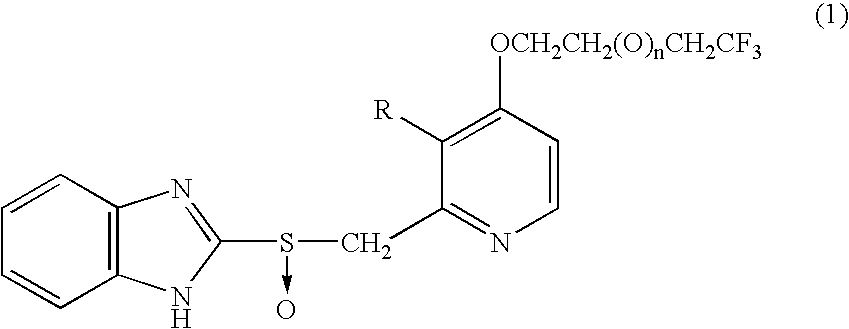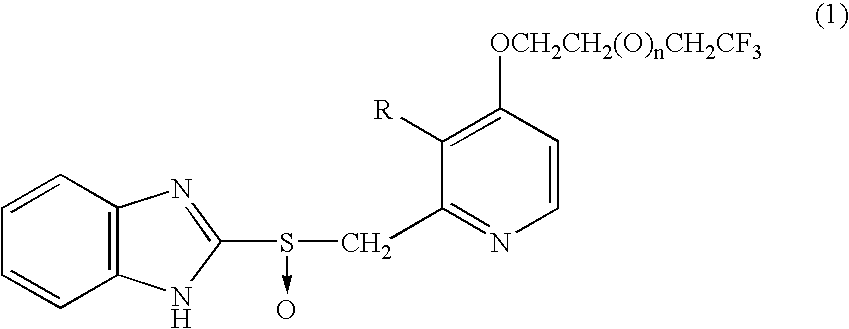Benzimidazole derivatives
- Summary
- Abstract
- Description
- Claims
- Application Information
AI Technical Summary
Benefits of technology
Problems solved by technology
Method used
Image
Examples
referential example 1
[0037](1) Acetic anhydride (400 mL) was added to 4-chloro-3-methoxy-2-methylpyridine-1-oxide (65.0 g), and the mixture was heated at 90° C. About three minutes thereafter, vigorous reaction was started, and the reaction was completed in 20 minutes. The solvent was removed under reduced pressure. Subsequently, toluene (50 mL) was added to the residue, and the solvent was removed under reduced pressure. The residual oil was employed in the following reaction.
[0038](2) The residue obtained in (1) was dissolved in methanol (200 mL), and a solution prepared by dissolving 85% potassium hydroxide (50.0 g) in 100 mL water was added to the mixture with stirring under cooling with an ice bath. The ice bath was removed, and stirring was continued at room temperature for 30 minutes. The reaction mixture was concentrated under reduced pressure (bath temperature: 40° C.), and water (400 mL) was added thereto, followed by extraction with methylene chloride (200 mL×3). Subsequently, combined organi...
referential example 2
[0048]4,4,4-Trifluorobutanol was added dropwise to a suspension of 234 mg sodium hydride (60% dispersion in oil) in 5 mL dimethyl sulfoxide under cooling with an ice bath. After completion of addition, the mixture was stirred for two hours at room temperature. 2-[(4-Chloro-3-methoxy)pyridin-2-yl-methylthio]-1H-benzimidazole (600 mg) was added to the reaction mixture. The mixture was heated to 60° C. (internal temperature) and stirred for two hours. The reaction mixture was poured on to crushed ice and water (50 mL), and saturated potassium hydrogensulfate solution was added until the pH of the mixture became 7, followed by extraction with ethyl acetate (30 mL×2). Organic layers were combined, washed sequentially with water and brine, and brought to dryness over sodium sulfate anhydrate. The solvent was removed under reduced pressure. The crystals thus produced were washed with n-hexane-isopropyl ether mixture, whereby 2-[3-methoxy-4-(4,4,4-trifluorobutoxy) pyridin-2-yl-methylthio]-1...
example 1
[0052](1) A 20 mL solution of 80% m-chloroperbenzoic acid (309 mg) in methylene chloride was added dropwise to a mixture of 2-[3-methoxy-4-(4,4,4-trifluorobutoxy)pyridin-2-yl-methylthio]-1H-benzimidazole (580 mg) in a solvent mixture of methylene chloride (5 mL) and dimethylformamide (25 mL) over 20 minutes under cooling with an ice bath. After completion of addition, the mixture was stirred for 50 minutes at the same temperature. The reaction mixture was poured on to a 50-mL crushed ice and saturated sodium bicarbonate solution, followed by extraction with ethyl acetate (30 mL×2). Organic layers were combined, washed twice with water and with brine, and subsequently brought to dryness over sodium sulfate anhydrate. The solvent was removed under reduced pressure. The residue was subjected to silica gel column chromatography (silica gel: NH-DM1020 (product of Fuji Silicia), chloroform:methanol=20:1), whereby 2-[3-methoxy-4-(4,4,4-trifluorobutoxy)pyridin-2-yl-methylsulfinyl]-1H-benzim...
PUM
| Property | Measurement | Unit |
|---|---|---|
| Fraction | aaaaa | aaaaa |
| Fraction | aaaaa | aaaaa |
| Fraction | aaaaa | aaaaa |
Abstract
Description
Claims
Application Information
 Login to View More
Login to View More - R&D
- Intellectual Property
- Life Sciences
- Materials
- Tech Scout
- Unparalleled Data Quality
- Higher Quality Content
- 60% Fewer Hallucinations
Browse by: Latest US Patents, China's latest patents, Technical Efficacy Thesaurus, Application Domain, Technology Topic, Popular Technical Reports.
© 2025 PatSnap. All rights reserved.Legal|Privacy policy|Modern Slavery Act Transparency Statement|Sitemap|About US| Contact US: help@patsnap.com



